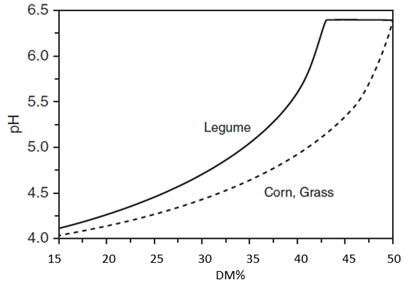
Silage pH: How low is low enough?

 By Cody McCary and Michelle Chang-Der Bedrosian, Ph.D., Vita Plus forage specialists
By Cody McCary and Michelle Chang-Der Bedrosian, Ph.D., Vita Plus forage specialists
Butyric fermentations occur in silages that are wet and have a high pH, which creates the ideal growth environment for Clostridia. A low pH is our best tool to combat clostridial fermentations, and the faster the pH can decrease the better. To decrease silage pH as quickly as possible, use of a powerful upfront fermenter, such as Crop-N-Rich® MTD/1®, at the time of ensiling can help.
But how low of a pH is low enough?
A recent publication (Forages: The science of grassland agriculture, by Richard Muck, published in 2020) showed the relationship between silage dry matter (DM) and the minimum pH to prevent the growth of Clostridia in silages.
 This chart can be used to determine how low the pH needs to be to prevent Clostridia growth. Locate your silage’s DM content and follow the curve to identify the corresponding pH value needed to suppress the growth of Clostridia.
This chart can be used to determine how low the pH needs to be to prevent Clostridia growth. Locate your silage’s DM content and follow the curve to identify the corresponding pH value needed to suppress the growth of Clostridia.
This shows that the wetter the silage the lower the pH needs to be to prevent the growth of Clostridia. For example, corn and grass silages that are harvested at 25% DM need a pH below roughly 4.25 to inhibit Clostridia growth. However, corn and grass silages that are harvested at 35% need only to accomplish a pH below roughly 4.60 to result in a similar inhibitory effect. Luckily, for corn and grass silages, this is not a difficult metric to achieve.
For alfalfa silages that are harvested at 25% DM, the minimum pH needed to suppress Clostridia growth is 4.40 and, for alfalfa silages harvested at 35% DM, the minimum pH is 5.0. Typically, the pH drops slower in legume silages due to a higher buffering capacity (the ability of a crop to resist a pH drop) and a low sugar concentration in this crop. Fermentation is the conversion of sugars into acids. Lactic acid is (ideally) the primary acid in silages, and this is the acid that decreases silage pH. In general, crops that have more sugars will have a lower pH.
However, many factors affect the decrease of pH in silages. It is important to understand that anything that changes the sugar content of silages will impact fermentation and silage pH. For example, silages that are harvested slowly (due to variables such as weather, labor or equipment) or have a delay in sealing will have a prolonged aerobic phase, and therefore less sugar content, resulting in a higher silage pH and an increased probability of Clostridia growth.
Good management practices can be used to decrease silage pH. Harvest silages at the right DM, put up the silage quickly, seal the silo promptly and with proven plastic, and use a high-quality inoculant.
| Category: |
Feed quality and nutrition Forage Foundations Forage harvesting Forage storage and management Silages |

